The Mysterious Little People of Japan
Posted by: mystery_man on June 8th, 2010
The Mysterious Little People of Japan
By – Brent Swancer
A commonly occurring phenomenon seen in the folklore and myth of a wide range of cultures throughout the world is the existence of miniature humanoid creatures. Faeries, dwarves, leprechauns, or by whatever other names they are known, mysterious little people of various types have consistently emerged as important elements of folklore across the globe since time unremembered.
On the island of Hokkaido, in the cold northern reaches of the Japanese archipelago, the indigenous Ainu people too have their long traditions of an ancient race of dwarf-like people thought to have inhabited the land long before humans arrived.
The Ainu knew these creatures as the Koropokkuru, also often written in other ways such as Kor-pok-un-kur, Koro-pok-guru, and Koro Pokunguru. They are also sometimes referred to as the Tsuchigumo. The name Koropokkuru is most commonly translated as “the people who live under the burdock leaves,” and implies the diminutive size of the creatures. In some stories a whole family was said to be able to fit underneath one burdock leaf, with one such leaf measuring about 4 feet across. The size reported for the Koropokkuru, however, actually varies from tradition to tradition, and they were said to be anywhere from 2 or 3 feet in height all the way down to only mere inches in height.
In addition to their small size, the Koropokkuru were said to be rather rough and primitive looking, with large heads, prominent brows, and short, squashed noses. They were sometimes said to have reddish skinned faces. Most commonly Koropokkuru are described as being rather hairy and odiferous. The non-Ainu Japanese of the time, and even early western explorers, already regarded the indigenous Ainu people as hairy brutes, and those who were acquainted with the Koropokkuru as well described these creatures as even more so.
Despite this brutish appearance, the Koropokkuru had some signs of sophistication. They were said to use flint or stone knives, scrapers, and other simple implements, and were also known for their ability in the art of pottery, which the Aiunu were not known to practice. Also unlike the Ainu, the Korropokkuru were said to dwell in pit dwellings, basically huts built over round holes in the earth, and this led them to sometimes be referred to as “the pit dwellers.”
The Koropokkuru were also known to be capable of speech, and were able to communicate with the Ainu in this manner.
According to Ainu lore, this dwarf race was exceedingly shy and did not like to be seen. Nevertheless, they were known to trade with the Ainu on occasion, although such transactions were brief and typically done under the cover of night. For the most part, the Koropokkuru were only fleetingly seen, and kept their distance from Ainu affairs.
The Koropokkuru and Ainu were said to have peacefully shared the land like this until a war broke out between them and the Koropokkuru were subsequently wiped out or driven away. After this disappearance and with the ever greater presence of mankind in Hokkaido, this mysterious race of ancient little people seemed to have vanished forever.
Was there any truth to any of these stories of small, humanoid creatures living in the wilds of Hokkaido, and if so what were they?
There has been some scattered evidence proposed over the years for such a non-Ainu race living in Hokkaido. Archeologists have found evidence of strange pit dwellings all over Japan that are consistent with the stories of the Koropokkuru dwellings, but not consistent with the Ainu, who have always lived in thatched houses. These pits have often been found to contain stone implements not typical of the Ainu, as well as mysterious tools that seem too small to be comfortable or efficient for normal human-sized hands.
Another archeological find that has been used in the past to support the existence of the Koropokkuru was made in 1877 by Edward S. Morse, one of the first to conduct proper archeological investigations in Japan. At a site known as the Ōmori shell mound, Morse found an array of anthropologically significant pottery in that it did not fit in with what was known about Ainu culture. The pottery conflicted with the lack of such a craft among Ainu, and the mystery deepened with Ainu denial that their ancestors had ever practiced it. Morse found this odd, and by the time he published his find in 1879, he had come to the conclusion that the Ōmori site was not an Ainu one, but rather that of some Neolithic race that predated the Ainu.
Morse’s paper on the matter, entitled Shell Mounds of Ōmori, was actually quite significant in its time, and is widely regarded as marking the birth of Japanese anthropology and archeology.
Tsuboi Shōgorō, a student of Morse as well as a founding member of the Anthropological Society and a later professor of anthropology at the Tokyo Imperial University, looked at the pottery and was mostly responsible for formulating a connection between these hypothetical ancient people and the dwarf-like Koropukkuru.
Tsuboi uncovered the Ainu stories of the Koropokkuru and was struck by the affinity for pottery that they were said to display, something that was not associated with the Ainu. He used this information to further support Morse’s claims and to build that into a case for the existence of these creatures. Based on the pottery, pit dwellings, and stone implements, all inconsistent with Ainu, Tsuboi hypothesized that these objects were not made by Ainu, but rather by the Koropokkuru.
Other anthropologists and scholars also came to similar conclusions, furthering the introduction of the Koropokkuru into academic discourse, however these ideas were highly controversial and fiercely debated at the time.
If there was indeed some sort of Stone Age race of half sized, tool using, pit dwelling humanoids in Japan, what were they and where did they come from?
One possibility is that the Koropokkuru were some type of race of pygmy humans. Pygmies are various ethnic groups around the world that are known for their small statures. These peoples are defined as pygmies if their average height is less than 150cm (4 feet 11 inches). Pygmies can be found in Africa, the Malay Peninsula, the Andaman Islands, New Guinea, and the Philippines. Many of these far flung pygmy groups share similar characteristics such as certain physical traits and social customs, which seems to suggest that they were perhaps more common in the past and may have shared a common ancestry.
If pygmies have been able to spread out over such distances and inhabit various islands and continents, it seems at least feasible that one such group of people could have at some point made its way to Japan. Although a lost tribe of Japanese pygmies may be behind stories of the Koropokkuru, the rough, brutish physical characteristics described by the Ainu seem to suggest that these dwarves may be something else entirely.
Many cultures around the world have long reported the existence of half-sized, hairy hominids lurking in the wilds of the world. These undersize hominids are known to many cryptozoologists as “Proto-Pygmies,” a term coined by the cryptozoologist Ivan T. Sanderson, originally as “proto-pigmies.” Proto-Pygmies are typically described as being bipedal and very human-like, only covered with hair, which is sometimes of differing lengths, and possessing rough features such as prominent brows and short, thick noses.
The possible existence of such seemingly fantastical creatures got a shot in the arm with the discovery of remains of a race of miniature hominids found on Flores Island in the Indonesian archipelago. The skeletal remains and other artifacts were found in Liang Bau Cave, on the Indonesian island of Flores, in 2003, and were first described in 2004. The creatures came to be known as Homo floresiensis, and are sometimes referred to as the “Hobbits of Flores.”
Research done on the relatively complete remains of a female specimen referred to as LB1, or the “Little Lady of Flores,” has shown that this full grown adult stood at a height of just 106cm (3 ft 11inches). It has also been established that these creatures were not merely dwarfed regular humans, but rather representatives of a completely new species of diminutive hominins.
Perhaps just as surprising as the existence of these creatures is that specimens found thus far have been dated as being 90,000 to 18,000 years old, which makes them contemporaneous with modern humans. It is thought that these “Hobbits” may have existed as little as 12,000 years ago, and maybe even beyond.
These creatures seem to have had a high level of intelligence and relatively sophisticated technology. Among the skeletal remains of Homo floresiensis found in the cave, there were stone tools, including advanced types such as flaked points and evidence of fire use, marking them as being probably at least as intelligent as the humans of the time.
Having such a wonderfully unique creature living contemporary to humans is exciting enough, but it also has far reaching implications for the various accounts of little hairy humanoids reported in modern times. If something like Homo floresiensis has managed to survive into the present day, it gives us a realistic basis upon which to base accounts of similar creatures throughout the region.
Already there are relatively contemporary accounts of pygmy hominids in the immediate area that survived until as recently as the 19th century. Among the local people, the creatures were known as the Ebu Gogo, which were said to be small, hairy, cave dwellers. Indonesia also has its stories of the Orang Pendek, a small hairy hominid that is often likened to Homo floresiensis. Stories such as these suggest that perhaps these Flores Hobbits have retained remnant populations in the region.
It would perhaps not be too unusual to find Homo floresiensis, or at least relatives of them, on other Indonesian islands. Stone tools linked to Homo floresiensis have been found on Flores that date back to 840,000 to 750,000 years ago, far predating the arrival of modern humans some 40,000 years ago. The question is how did they get there? Flores Island has long remained isolated, with no land bridges for such creatures to cross. Even when sea levels were at their lowest, Flores was still separated from the mainland by 24 km (15 miles) of water. This suggests that in addition to their tool use and ability to utilize fire, Homo floresiensis, or their ancestors, were able to cross sea barriers as well, perhaps by using some sort of primitive rafts.
The idea of sea going ancestors of Homo floresiensis opens up a whole world of possibilities regarding Proto-Pygmies beyond Flores Island and even Indonesia. In fact, stories of hairy little people are scattered throughout Oceania.
Hawaii has its Menehune, 2 to 3 foot tall hominids with stout, muscular bodies, low foreheads, and reddish faces. Interestingly the Koropokkuru similarly are described as having red faces. Ceylon has a type of 3 foot tall hairy hominid known as the Nittaewo. Fiji too has stories of tiny, 2 foot tall hairy dwarves. On the island of Palau, remains were found of an “insular dwarf” that dated to a mere 900 – 2,800 years ago. The northern mountains of Queensland, Australia have long been thought to be the haunt of a race of miniature hairy humanoids known as the Junjdy. These beings were said to be half the size of the native Aborigines.
Is it possible that Homo floresiensis, or their ancestors, possibly Homo erectus, spread out throughout Oceania and evolved in isolation into the many kinds of Proto-Pygmies reported today from these far flung places?
If so, could such creatures not have made it to other parts of the Pacific as well, including Japan?
Certainly if these creatures did cross sea barriers and manage to inhabit a place as far from Indonesia as Hawaii, the idea that they could have reached Japan should not be too entirely far-fetched.
A Proto-Pygmy related to the Flores hobbits would fit in quite well with the stories of the Koropokkuru. The appearance seems to bear a resemblance, as does the use of stone tools present in both of these creatures. It is thought that Homo floresiensis was quite possibly capable of speech, although to what extent is not well understood. This ability to speak could possibly explain why the Koropokkuru had the ability to interact and trade with the Ainu, at least in some rudimentary manner. Indeed the vocalizations often reported with Proto-Pygmies in other parts of the Pacific could also be explained by this ability to produce speech.
A remnant population of an ancestor of Homo floresiensis, evolved in isolation on the island of Hokkaido, Japan, does not seem to be a completely impossible notion especially when considering what we know of these “Flores Hobbits” and the amount of Proto-Pygmy accounts scattered throughout the Pacific region. Maybe the presence of these early hominids was more far-reaching than is currently suspected.
It is also possible that these creatures may even be remnant populations of some early early human ancestor such as Homo erectus, possibly displaying island dwarfism and other adaptations due to the geographical isolation on the island of Hokkaido.
Although there are no modern accounts of the Koropokkuru, the mystery remains. Did these Japanese Proto- Pygmies exist? Was there ever a race of ancient, miniature hominids that lived contemporaneously with human beings in Japan? If so, what could they have been? Were they a population of pygmy hominids or merely folkloric shadow creatures from another time?
These are questions for which we have no answers at this point. Yet perhaps the answers are somewhere out there right now in the cold, expansive wilderness of Hokkaido.
About mystery_man

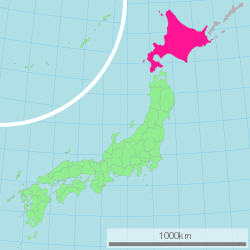



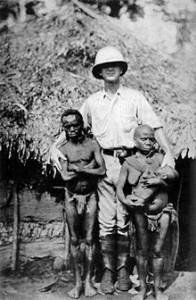
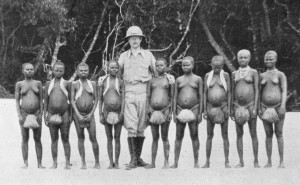
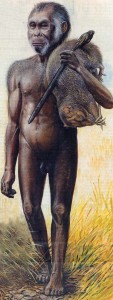
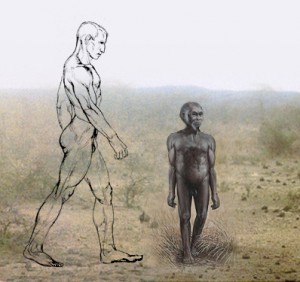
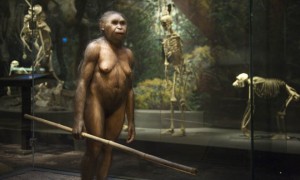
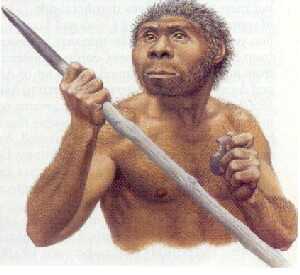








This is, of course, an important contribution from Brent Swancer. While other cultures’ Proto-Pymgies have been well-documented, how could the Japanese varieties be ignored for so long within hominology/cryptozoology?
The discovery of the “hobbits” (Homo floresiensis) certainly means it is time to re-focus our efforts on studying the Orient, South Pacific, Pacific Rim, and South Asia “Little People” accounts. I very much appreciate Brent for his sharing this brief survey of Japan’s Koropokkuru with us here at Cryptomundo.
Of course, this little sculpture fascinates me. It shows a characteristic of some Proto-Pygmies that have been noted for decades, the reports of Little People holding large elephant-ear-shaped leaves over their heads.
A similar behavior was acknowledged in the scientific literature, a couple decades ago, for the bonobos, from coincidentally, a member of the medical staff at University of the Ryukyus, Okinawa, Japan, Dr. Takayoshi Kano. His paper, “The use of leafy twigs for rain cover by the pygmy chimpanzees of Wamba,” was published in the journal Primates, 23 (3), pp. 453-457, July 1982.
The abstract reads: “Pygmy chimpanzees (Pan paniscus) of Wamba sometimes put leafy twigs on their bodies in a rain. In some cases, those twigs seemed to be effective against the rain-impact. There is no record that common chimpanzees (Pan troglodytes) show the same behaviour, but similar or more elaborate use of twigs as rain cover is recorded among orang-utans (Pongo pygmaeus).”
I cannot come across the account I wanted to quote because I can’t relocate it right now, but, if I recall correctly, Heuvelmans or Sanderson repeated a firsthand account of an eyewitness watching this behavior in Africa, when watching a Proto-Pygmy.
It is interesting that Loren mentions the accounts of Proto-Pygmies with large leaves held over their heads.
This sort of behavior is not only shown here on this sculpture, but is often cited in Ainu lore on these creatures, and is well represented in various artwork depicting the Koropokkuru.
That is certainly yet another curious detail that connects these Japanese Proto-Pygmies with their more well known brethren.
I am pleased that I could shed light on this little known Japanese mystery, perhaps expand the available literature on these overlooked Proto-Pygmies, and add some more focus on the implications that Homo floresiensis has on Proto-Pygmies throughout South Asia and the Pacific.
As with Loren, it is amazing to me that these Japanese Proto-Pygmies have remained so ignored within hominology and cryptozoology, at least in the English language. They remain little understood by many even in Japan, and so of course I had to dig into this mystery and write an overview here.
This article has been something I’ve been turning over in my head, researching, and wanting to contribute for quite some time, so I greatly appreciate Loren’s words of praise.
I hope the readers here will enjoy this and learn something about an Asian Proto-Pygmy they may have never heard of before.
Amazing article! I find it highly likely that these types of Proto-Pygmies existed in much larger numbers than we currently consider. Why is it that we assume that due to their stature and primitive nature that they couldn’t cross waterways, either by “planned expedition” or by “getting caught in a current?” This is a fascinating topic that I fully intend to study in further detail.
Also, for what it’s worth, it is interesting to look at the comparison between modern man and Homo floresiensis. I can’t help but wonder how far back the ideas for our “modern” folk tales go. Could it be, that at one time, WE were the giants that dominate so much of “primitive” literature?
This was a splendid article. Well-done!
Certainly if you did a number of these sorts of papers/articles, they could be the chapters in a new cryptozoological book focusing on mystery pygmy humanoids, perhaps even focusing on the Pacific Rim, as Loren notes.
A stimulating foray into the unknown, or perhaps better put as the “nearly-known”. It seems hard to believe there could be intelligent forms of archaic or proto human living among us and we not know of them living in the here and now despite their living in the remote and difficult landscapes where modern humans rarely go because they are so difficult, but then I think we over-estimate our capacity to detect especially those animals whose instincts are directing them to avoid contact with ‘the others’ such as we would likely seem to them, and simultaneously under-estimate just how good an archaic human might be at remaining unseen by those whose very behavior tell them that they are searching for them as quarry. The notion that modern humans are great at finding other humans is routinely shown to be not true whenever kids get lost even in places that are not that distant or remote, let alone adults with some outdoors skills who are avoiding a man-hunt, such as the infamous Eric Rudolph case a few years ago.
Just as with the archaic human remains found of Flores, it’s most instructive to try to imagine what the physical geography of the Asian coastline would have been like, and where we might ordinarily expect to find the remains of their activity, in contrast to what we have in the present day, and it becomes easier to understand why we don’t find fossil deposits of their remains or artifacts. All in all, a fascinating area for further consideration, and again, thanks to Brent for his enlightening examinations. cheers.
Fascinating article!
I agree, that Homo floresiensis is a likely candidate for these myths. When I was in Hawai’i I learned about the Menehune legends, and from what I’ve read these “little people” myths persist throughout Polynesian culture.
A random thought, regarding this issue and the Bible. Whether you view it as the as a God, an alien (technically God would be an alien), or just a document recording events that occurred at that time.
What if all these pygmies, or little people as we call them, weren’t little at all. Rather we are the giants, the Nephiliam, the offspring of the angels and women.
Far fetch, I know. But it was an amusing thought to toy with.
Are you aware of the hobbit-type people who lived in the mountainous regions of western North America? Indian legends tell of an aggressive, warlike tribe of miniature people. An Indian museum on the Wind River Reservation in central Wyoming has an exhibit which shows photos of x-rays taken of the mummified remains of one of the creatures.
Great article Brent!!
@scoutonymous: They were found to be malformed babies, source: University of Wyoming: Tiny Mummies are not The Prehistoric Little People
I don’t think human all over the place have been followed by little people. But since we do share a common set of stories (pre-historic history) it’s more than likely that they stem from an original actual story of a separate, tiny people our earlier ancestors knew intimately.
I don’t think it’s fair, though, to count elves and other supernatural beings into this as they usually have a specific magical role in a tale (“fairy tales” as they are called, were used to teach moral behaviour).
I don’t think these accounts reflect necessarily a population spread throughout Oceania, but may rather be traditional stories told by modern human groups whose ancestors had passed through areas occupied by the little people.
I would want to ask, though, where are the skeletons? Do the Flores skeletons show marks of idiosyncratic or special treatment?